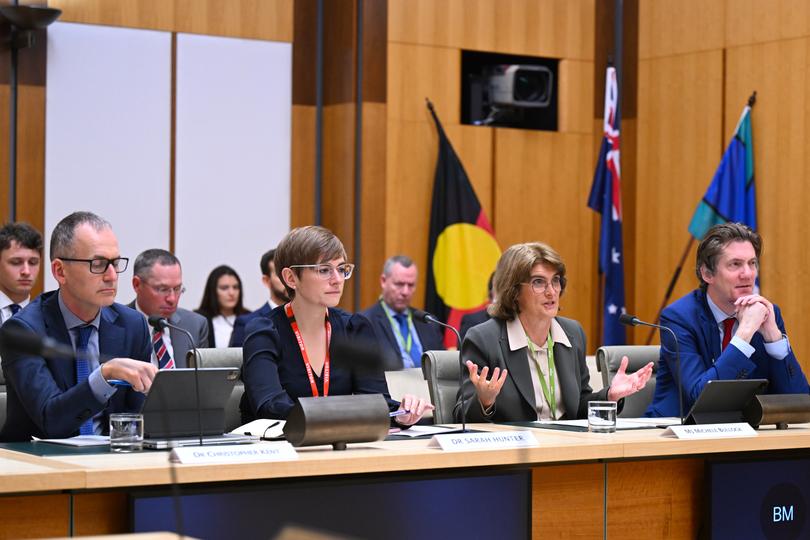RBA governor Michele Bullock says rate cut talk ‘premature’ as she delivers reality check to borrowers
Reserve Bank governor Michele Bullock has cautioned it’s “premature to be thinking about rate cuts” in a lengthy grilling where she downplayed the role of federal government spending in persistent, stubbornly high inflation.
In a marathon three hour appearance before the House of Representatives’ economics committee on Friday, Ms Bullock acknowledged the pressure interest rates — which were held steady at 4.35 per cent at last week’s board meeting — were putting on borrowers but was unapologetic in the bank’s determination to get inflation back to target.
She said public demand was “not the main game”, saying instead price pressures in the services sector, consumption, rents, and residential construction were the “big swing things that are going to impact us over the next year or so”
Sign up to The Nightly's newsletters.
Get the first look at the digital newspaper, curated daily stories and breaking headlines delivered to your inbox.
By continuing you agree to our Terms and Privacy Policy.Ms Bullock lamented the progress on returning CPI back to the two to three per cent target range had been “very slow”, meaning that was now not expected to happen until next year and into 2026.
That remained the bank’s priority, Ms Bullock said, and the board wouldn’t seriously turn its mind towards cutting rates — which the markets are pricing will happen this year — until more progress had been made.
“Circumstances may change, of course, and the outlook remains uncertain. But based on what the board knows at present, it doesn’t expect it will be in a position to cut rates in the near term,” she said.
“I understand that is not what households want to hear. Those with mortgages are feeling the squeeze on their cash flows from the increase in interest rates over the past couple of years... But the alternative of higher inflation for longer is much worse.
“High inflation hurts everyone.”
While inflation has moderated from its peak in the December 2022 quarter, much of that reflected a stabilising price growth in goods.
Pressures in the labour-intensive services sector, meanwhile, remained too high and were the biggest contributors to prolonged inflation.
“Inflation in services prices, on the other hand, has remained high, running at around 5 per cent,” Ms Bullock said.
“There’s been broad-based inflation in market services, reflecting continued demand and the ability for some businesses to pass through costs.”

She singled out rents, construction costs and insurance as other contributors to high inflation.
In the wake of a brouhaha over Ms Bullock’s post-board meeting comments last week that public spending was part of the inflation problem, she told the committee on Friday it was not the biggest priority.
“It’s not the thing that we are focusing on. We’re focusing on getting inflation down and the uncertainties around the economy that are going to impact us one way or the other, and those things are centred in consumption, trade and residential construction,” she said.
However, she did reveal the “large chunk” of public demand pressure was coming from state governments, not the Commonwealth.
“I wouldn’t want to put a specific number on it, but I’d say probably the majority of it would be a large majority of it would be state,” she said.
She added the two consecutive budget surpluses banked by the federal government had kept public demand lower than if it had spent the windfalls.
Ms Bullock said pressures within the housing market were having a broad impact on the economy, but denied the interest rate rises were driving up rents. saying instead it was because of a lack of supply.
She said construction costs, which rose 5.1 per cent over the last year, were part of the problem, and noted it took considerably longer to build a house now than it did before the pandemic.
“Construction costs have continued to rise more in Australia … and that’s meant that our goods price inflation has been a little bit higher than overseas,” she said.
She added that public infrastructure and non-residential construction projects were diverting workers away from building homes, which further slowed down the pipeline.
Consumers are tightening their belts, in line with the bank’s expectations, with Ms Bullock saying discretionary spending was no longer growing, especially among mortgage holders.
“We are also hearing from (a) liaison that people are tending to go for value. So they might not buy the most expensive brand of something. They might buy the cheaper brand,” she said.
Ms Bullock also said those who own their home outright, who aren’t feeling the pinch of interest rates, weren’t working against the RBA’s efforts to curtail spending because they are capitalising on higher rates on savings accounts.
“When interest rates go up, you’re encouraged to save rather than spend. And so even people who don’t have mortgages are encouraged by the higher interest rates to save a bit more than they ordinarily would,” she said.
Looking further afield, Ms Bullock told MPs there was a lot of uncertainty in the global economy, namely a further slowdown in the Chinese economy and ongoing geopolitical tensions which could pose a risk to Australia.
The Chinese economy continues to be bogged down by a debt-ridden property sector which has hampered growth.
“That is something that we’re watching quite closely because developments in China can have quite a big impact on the way our trade develops, and that therefore on our growth,” she said.
Geopolitical tensions, meanwhile, which lead to supply chain disruptions risked adding further inflationary pressure.
“We would like to look through supply shocks, but if they’re consistent and persistent, it makes it very difficult to just completely ignore them and the potential impact they might have … on inflation expectation and the level of inflation,” she said.
Ms Bullock and assistant governor Brad Jones also sought to allay concerns about insolvencies, saying while they were on the rise, they weren’t back at pre-pandemic levels.

